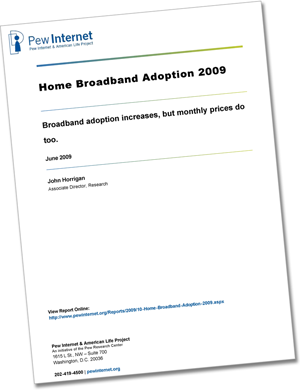 Readers of Minnov8 are skewed toward those highly interested or involved in internet and web-centric technology and services. As such, the latest findings of the Pew Research Center’s Internet & American Life Project will be of significant interest.
Readers of Minnov8 are skewed toward those highly interested or involved in internet and web-centric technology and services. As such, the latest findings of the Pew Research Center’s Internet & American Life Project will be of significant interest.
These findings illustrate a departure from the stagnation in home high-speed adoption rates that had prevailed from December, 2007 through December, 2008. During that period, Project surveys found that home broadband penetration remained in a narrow range between 54% and 57%.
The greatest growth in broadband adoption in the past year has taken place among population subgroups which have below average usage rates. Among them:
- Senior citizens: Broadband usage among adults ages 65 or older grew from 19% in May, 2008 to 30% in April, 2009.
- Low-income Americans: Two groups of low-income Americans saw strong broadband growth from 2008 to 2009.
- Respondents living in households whose annual household income is $20,000 or less, saw broadband adoption grow from 25% in 2008 to 35% in 2009.
- Respondents living in households whose annual incomes are between $20,000 and $30,000 annually experienced a growth in broadband penetration from 42% to 53%.
Overall, respondents reporting that they live in homes with annual household incomes below $30,000 experienced a 34% growth in home broadband adoption from 2008 to 2009.
- High-school graduates: Among adults whose highest level of educational attainment is a high school degree, broadband adoption grew from 40% in 2008 to 52% in 2009.
- Older baby boomers: Among adults ages 50-64, broadband usage increased from 50% in 2008 to 61% in 2009.
- Rural Americans: Adults living in rural America had home high-speed usage grow from 38% in 2008 to 46% in 2009.
The Pew Internet Project’s April 2009 survey interviewed 2,253 Americans, with 561 interviewed on their cell phones.
As I read the report, it was clear that this acceleration in broadband adoption is, in my view, being driven by a number of variables: economic downturn causing a seeking of alternatives, efficiency and cost savings; friends, family and colleagues online (many using social media) creating compelling reasons for others to connect; and a continuing growth of online services in news, information, entertainment and more.
All that said, the important thing to Minnesota innovators is that people are increasingly online at home and participating, and that’s important to all of us in the internet and web innovation space!